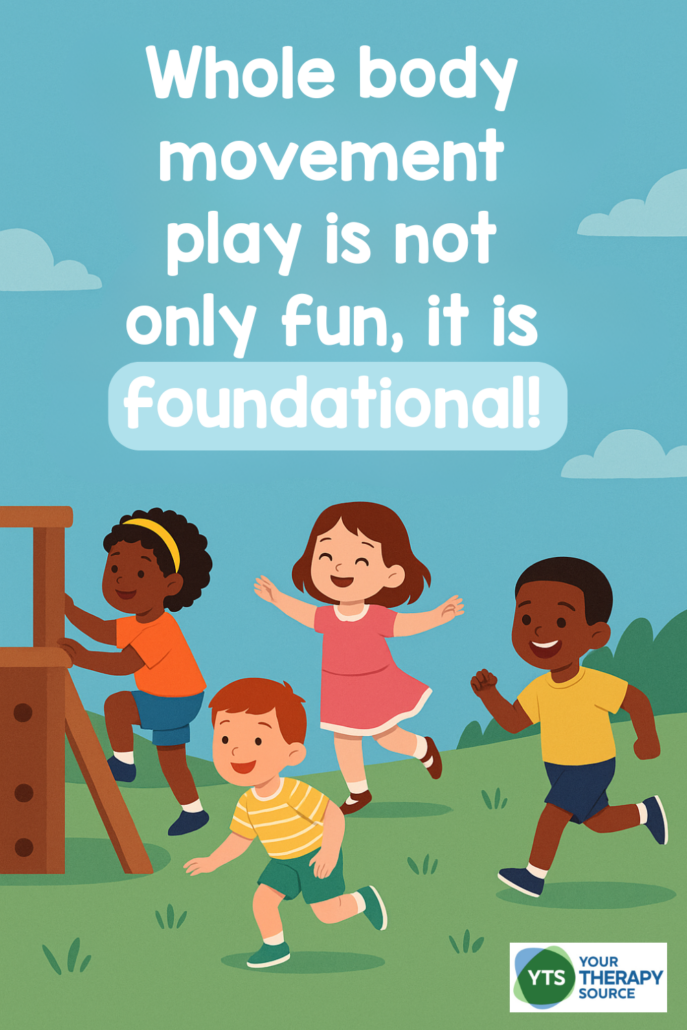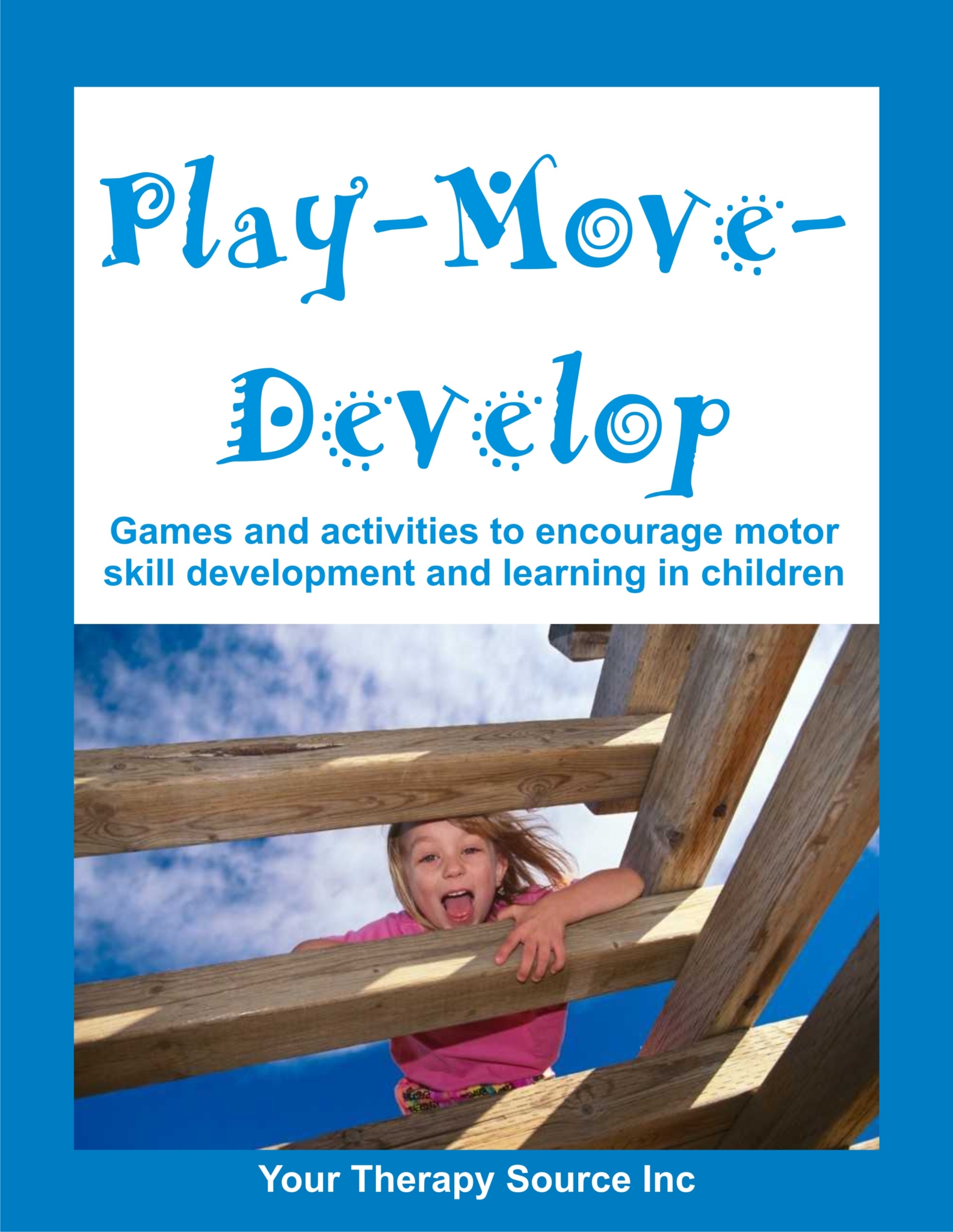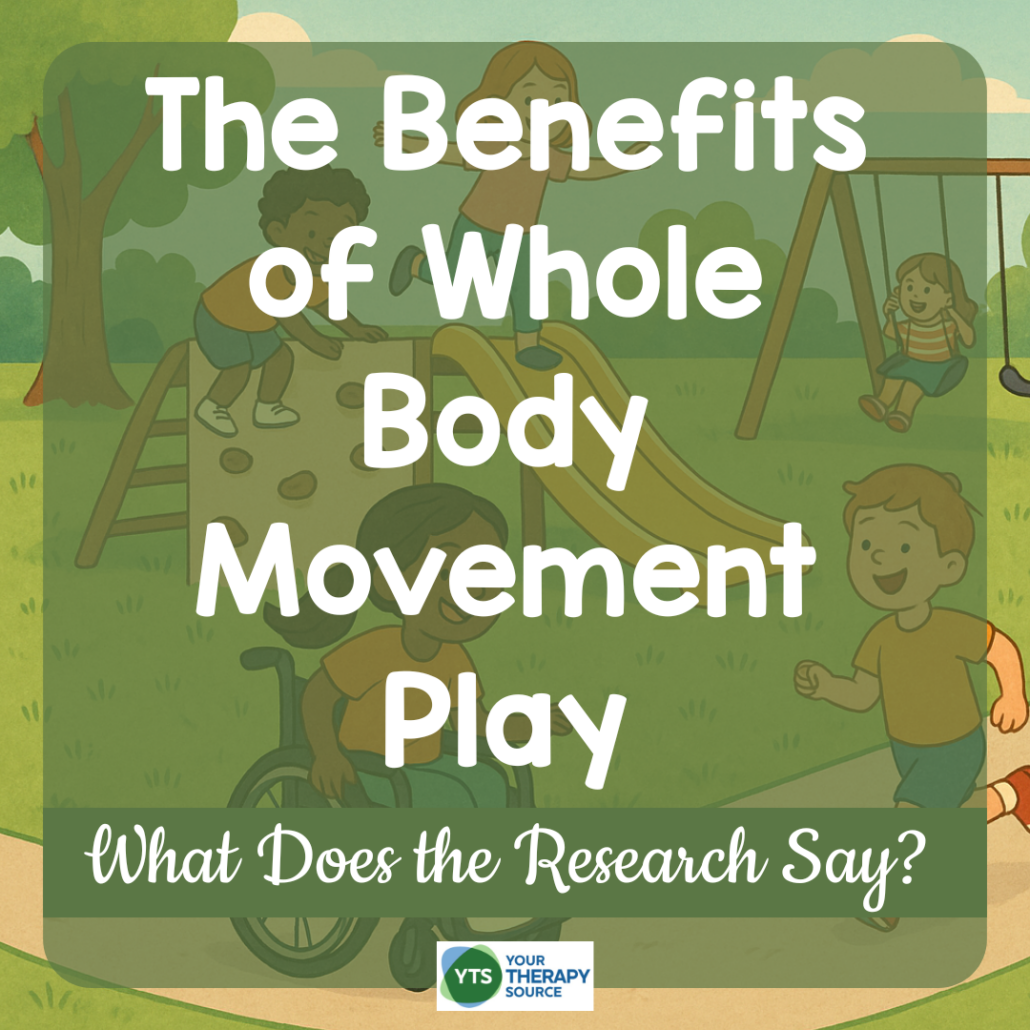The Benefits of Whole Body Movement Play
Whole body movement play is not just fun, it’s foundational. When children climb, crawl, spin, balance, or chase, they’re doing more than being active. These full-body movements support brain development, emotional regulation, social interaction, and physical coordination. Play that engages the whole body helps children develop, especially when the environment invites exploration, imagination, and physical challenge.
For children with and without disabilities, play-based movement can spark developmental progress in ways that structured exercise cannot. It’s spontaneous, joyful, and often more meaningful because the child is leading the activity.

What Is Whole Body Movement Play?
Whole body movement play includes any activity that encourages large motor movement during play. These are often child-led, imaginative, and multi-sensory. Examples include:
- Building a fort with couch cushions and crawling inside
- Jumping from one shape to another in a pretend lava game
- Pulling a wagon, pushing a box, or rolling down a hill
- Dancing freely to music
- Swinging, climbing, or balancing outdoors
- Playing tag, hide-and-seek, or chasing bubbles
Unlike adult-directed workouts, these activities are driven by curiosity, creativity, and sensory-motor input. They naturally support the development of thinking, movement, and emotional control.

Play – Move – Develop
Cognitive Benefits of Whole Body Play
When children use their entire bodies to move through space, they activate brain regions responsible for executive functioning, skills like attention, impulse control, and flexible thinking. These skills are critical for learning in the classroom and in daily life.
A recent meta-analysis of movement-based interventions for young children found that whole-body, play-centered activity led to improvements in inhibitory control, working memory, and cognitive flexibility (Wei et al., 2024). These improvements were strongest when the activities were playful and involved rules, problem-solving, or imaginative scenarios.
Emotional Regulation Through Movement
Play that involves full-body movement helps children manage their energy and emotions. Jumping, swinging, crashing safely into cushions, or spinning can help children calm themselves or release tension. These movements provide sensory input that helps regulate the nervous system.
In a clinical report, the American Academy of Pediatrics emphasized that child-led, joyful play helps reduce stress, build resilience, and support emotional development (Yogman et al., 2018).
Social Interaction and Communication
When children play together in a movement rich environment, they naturally practice:
- Taking turns
- Negotiating rules
- Expressing their ideas
- Reading body language and facial expressions
Whole body play settings, like climbing structures, obstacle courses, or pretend adventures, create low-pressure opportunities for social connection.
For children with autism, movement-based group play can be especially beneficial. A 2024 meta-analysis found that interactive movement activities helped children with ASD improve their ability to engage with peers and follow social routines (Koh, 2024).
Why Movement-Based Play Is Especially Important for Children with Autism
Children with autism spectrum disorder (ASD) often face challenges with attention, behavior, and sensory regulation. A recent pilot study found that children with ASD who participated in play-based, whole-body movement activities showed:
- Better impulse control
- Fewer sensory-seeking and negative behaviors
- More on-task behavior during play
In contrast, children in sedentary play sessions did not show these gains. The researchers emphasized that movement and play should be used together to support executive functioning and behavior in children with ASD (Su, Srinivasan, & Bhat, 2025).
How Adults Can Support Whole-Body Play
Play doesn’t need to be chaotic or unstructured to be effective. Adults can set up environments that invite movement and exploration while allowing the child to lead.
Try these strategies:
- Set up obstacle courses with tunnels, balance beams, and jumping spots
- Create pretend play stations that involve movement (e.g., firefighter training course or animal adventures)
- Use outdoor spaces for running games, climbing, and hide-and-seek
- Offer large cardboard boxes, pillows, and crash pads for fort building or movement-based sensory play
- Rotate materials often to spark new movement ideas
In classroom and therapy settings, these kinds of play stations can be set up in small spaces and rotated for novelty. The key is that children are moving with purpose, joy, and autonomy.
Play Builds the Brain and Buffers Stress
Play that includes full-body movement doesn’t just support development, it protects it. When children experience nurturing, joyful play with trusted adults, their brains build strong foundations for lifelong learning.
Developmentally appropriate play helps children develop:
- Social-emotional awareness
- Language and communication
- Self-regulation and resilience
- Executive function, including goal-setting and focus
These experiences also protect the brain from the effects of toxic stress. Joyful play with responsive caregivers, often called “serve and return” interaction, regulates the child’s stress response system. This buffering effect is especially important for children exposed to adversity.
Without opportunities for safe, connected play, children may struggle to develop executive function or prosocial behavior. In these cases, play becomes even more critical (Yogman et al., 2018).
As some schools and early childhood programs face pressure to reduce play in favor of academic instruction, educators and healthcare providers can advocate for balance. Supporting playful, full-body movement is not a luxury. It is a necessity for healthy child development.
Whole-body play is a powerful tool to support child development. It activates the brain, builds emotional resilience, encourages social learning, and helps children regulate their energy and behavior. Unlike structured exercise routines, whole-body play is flexible, creative, and rooted in how children naturally explore the world.
Teachers, therapists, and parents can all support development by designing spaces that invite movement through crawling, climbing, jumping, spinning, and pretending. These experiences don’t just support physical health; they build the foundation for learning, relationships, and well-being.
References about Whole Body Movement Play
Koh, S. H. (2024). Analyzing the influence of physical exercise interventions on social skills in children with autism spectrum disorder: A meta-analysis. Frontiers in Psychology, 15, 1399902. https://doi.org/10.3389/fpsyg.2024.1399902
Su, W. C., Srinivasan, S., & Bhat, A. N. (2025). Effects of movement and sedentary play interventions on executive functioning and their relationships with sensory, repetitive, and negative behaviors of children with ASD – a pilot RCT. Disability and Rehabilitation. https://doi.org/10.1080/09638288.2025.2465600
Wei, Y., Wang, L., Tang, Y., Deng, H., Su, J., & Li, Q. (2024). Enhancing young children’s executive function through physical activities: A three-level meta-analysis. Mental Health and Physical Activity, 26, 100592. https://doi.org/10.1016/j.mhpa.2023.100592
Yogman, M., Garner, A., Hutchinson, J., Hirsh-Pasek, K., & Golinkoff, R. M. (2018). The power of play: A pediatric role in enhancing development in young children. Pediatrics, 142(3), e20182058. https://doi.org/10.1542/peds.2018-2058



